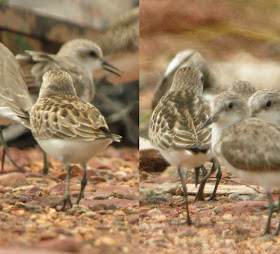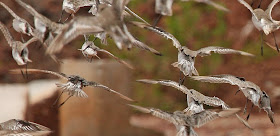rWith the tides looking good again it was time to take another visit to the roost site. Unfortunately this roost only seems to pull in the smaller waders, but that still means a wonderful flock of 3-4,000 birds, and the chance of something exciting among them.

Among the first few birds to arrive was a stunning juvenile Little Stint. I've only ever seen one juvenile in Malaysia, back on 23rd Sept 2007, so I was really looking forward to getting to grips with another one. Unfortunately, distance and the heat haze prevented me from getting sharper shots, but I was happy nonetheless!

The things that make this bird stand out from a juv Red-necked are:
1. The evenly dark-centred, pale-fringed scapulars and coverts. Red-necked tend to have a dark subterminal spot with pale base (lower scapulars) and rather bland, grey-centred, pale fringed coverts.
2. The well-streaked breast sides. Red-necked has indistinct streaking and usually a greyish wash which extends across the breast.
3. The well-marked head, with dark ear coverts and central crown and white 'double supercilium'.
4. The characteristic sturctural differences - fine-tipped bill and longer legs, and typically more upright stance.

This was my sharpest shot. The upper scapular fringes have slightly gingery fringes, but do not contrast markedly withe lower scapulars as they do on many Red-neckeds. The mantle is very dark except for the pale 'tramlines'.

This blurry shot shows the dark central crown.

A composite illustrating some of the differences I mentioned above (Little on the right).
A few more juv Red-necked for comparison:

A fresh juvenile.

This one has just started moulting into first winter plumage (a few mantle feathers). Note how indistinct the streaking on the breast sides is.

This one is more advanced in moult.

The central crown is quite uniform and not particularly dark.

Nothing is quite so well-marked as a...

...juvenile Broad-billed Sandpiper! I'm not addicted to juv Broad-bills. Honest! Just a couple more...


Oh - and one more in flight!

Broad-billed Sands have a dark leading edge to both the upper and undersides of the wing. The upper lesser coverts are blackish at all ages and the resulting dark forewing and pale hind wing is quite distinctive.
I've always wondered whether mid-air collisions ever happen when waders are flying in flocks.

Today I think I caught a collision of a few Curlew Sandpipers on camera

The barring on the rump of a Curlew Sandpiper in worn breeding plumage can be surprisingly extensive.



Did I mention what mighty fine-looking birds juv Curlew Sandpipers are?
There's been a renewed debate on the subtleties of sand plover identification recently with the occurrence of a tricky bird in Virginia, USA (See here and here). I've always struggled to see the difference between these two species in flight, apart from the bill. Hirschfield, Roselaar and Shirihai, in their paper on sand plovers, suggest that Greater has a darker terminal band on the tail than Lesser.

Greater.

Lesser.
Can't see it myself.
They also mention that Lesser has 'dusky underprimary coverts' which form a dark comma at the bend of the wing, a feature which is supposedly lacking in Greater.

Greater.

Lesser.
Hmmmm!

Some more Lesser Sand Plovers, with four other species for company - Terek, Curlew and Broad-billed Sandpipers and Red-necked Stint.

Comin' at ya!

A Terek side-on.

A lonesome Common Redshank - easier heard than seen!

Getting jumpy! The tide must be going out and these birds are getting ready to go.

Angel wings!

It fell off the back of a lorry! A couple of abandoned site vehicles make a useful basis for a hide.

Elsewhere I saw my 1st, 2nd, 3rd, 4th, ...48th, 49th and 50th Brown Shrike of the season! It rained last night and there was obviously quite an arrival.

Whoops! One of the hazards of driving heavy machinery in soft, wet mud!

There were lots of these fellas in the paddyfields at Kubang Semang, but getting a good view was another matter. This one is moulting out of breeding plumage and has lost its tertials. Well - it's a snipe, not Common, but whether Pintail or Swinhoe's I wouldn't like to say!

Among the first few birds to arrive was a stunning juvenile Little Stint. I've only ever seen one juvenile in Malaysia, back on 23rd Sept 2007, so I was really looking forward to getting to grips with another one. Unfortunately, distance and the heat haze prevented me from getting sharper shots, but I was happy nonetheless!

The things that make this bird stand out from a juv Red-necked are:
1. The evenly dark-centred, pale-fringed scapulars and coverts. Red-necked tend to have a dark subterminal spot with pale base (lower scapulars) and rather bland, grey-centred, pale fringed coverts.
2. The well-streaked breast sides. Red-necked has indistinct streaking and usually a greyish wash which extends across the breast.
3. The well-marked head, with dark ear coverts and central crown and white 'double supercilium'.
4. The characteristic sturctural differences - fine-tipped bill and longer legs, and typically more upright stance.

This was my sharpest shot. The upper scapular fringes have slightly gingery fringes, but do not contrast markedly withe lower scapulars as they do on many Red-neckeds. The mantle is very dark except for the pale 'tramlines'.

This blurry shot shows the dark central crown.

A composite illustrating some of the differences I mentioned above (Little on the right).
A few more juv Red-necked for comparison:

A fresh juvenile.

This one has just started moulting into first winter plumage (a few mantle feathers). Note how indistinct the streaking on the breast sides is.

This one is more advanced in moult.

The central crown is quite uniform and not particularly dark.

Nothing is quite so well-marked as a...

...juvenile Broad-billed Sandpiper! I'm not addicted to juv Broad-bills. Honest! Just a couple more...


Oh - and one more in flight!

Broad-billed Sands have a dark leading edge to both the upper and undersides of the wing. The upper lesser coverts are blackish at all ages and the resulting dark forewing and pale hind wing is quite distinctive.
I've always wondered whether mid-air collisions ever happen when waders are flying in flocks.

Today I think I caught a collision of a few Curlew Sandpipers on camera

The barring on the rump of a Curlew Sandpiper in worn breeding plumage can be surprisingly extensive.



Did I mention what mighty fine-looking birds juv Curlew Sandpipers are?
There's been a renewed debate on the subtleties of sand plover identification recently with the occurrence of a tricky bird in Virginia, USA (See here and here). I've always struggled to see the difference between these two species in flight, apart from the bill. Hirschfield, Roselaar and Shirihai, in their paper on sand plovers, suggest that Greater has a darker terminal band on the tail than Lesser.

Greater.

Lesser.
Can't see it myself.
They also mention that Lesser has 'dusky underprimary coverts' which form a dark comma at the bend of the wing, a feature which is supposedly lacking in Greater.

Greater.

Lesser.
Hmmmm!

Some more Lesser Sand Plovers, with four other species for company - Terek, Curlew and Broad-billed Sandpipers and Red-necked Stint.

Comin' at ya!

A Terek side-on.

A lonesome Common Redshank - easier heard than seen!

Getting jumpy! The tide must be going out and these birds are getting ready to go.

Angel wings!

It fell off the back of a lorry! A couple of abandoned site vehicles make a useful basis for a hide.

Elsewhere I saw my 1st, 2nd, 3rd, 4th, ...48th, 49th and 50th Brown Shrike of the season! It rained last night and there was obviously quite an arrival.

Whoops! One of the hazards of driving heavy machinery in soft, wet mud!

There were lots of these fellas in the paddyfields at Kubang Semang, but getting a good view was another matter. This one is moulting out of breeding plumage and has lost its tertials. Well - it's a snipe, not Common, but whether Pintail or Swinhoe's I wouldn't like to say!
This is awesome! Amazing number of birds. That should be an important stage of our shorebird expedition. :)
ReplyDeleteSzimi
nice pics you have there, especially the angel wings and how the bird maintains its head level in flight.
ReplyDelete